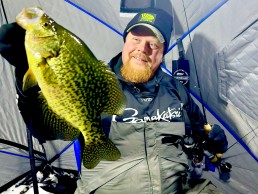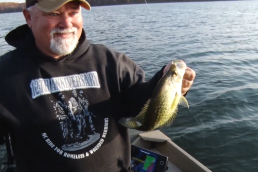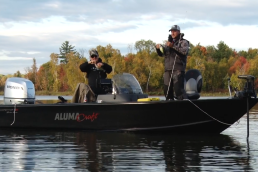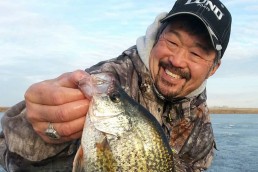‘Zombie’ Crappies
SHARE THIS POST
One of my favorite things about midwinter is the accessibility of fishing spots that I didn’t have during early ice. I have the ice affliction bad! By this time of year, I have walked hundreds of miles by foot from shore and cut nearly a thousand holes with my RAZR Synthetic Ultra Auger. I’ve traveled multiple lakes, pulling basic essentials in an Otter Utility Sled. This is my definition of fun, but I’m ready to hit the “easy” button and bring more of my creature comforts, such as an Otter Resort flip-over style house.
By January, I am usually able to get around with machines such as a snowmobile, four-wheeler and even a side-by-side UTV. Some years, resorts have basic ice roads plowed and we drive small trucks. Machine travel allows me to cover two to twenty miles fast on the numerous 2,000- to 50,000-acre lakes—and some even larger—in northern Minnesota.
A large percentage of these lakes have basin-dwelling crappies during winter. They move away from hard-bottom shoreline edges and weed beds to deeper holes with mud bottoms. The mud in the basin is fertile and teeming with life, such as young-of-the-year hatches from every species of fish and minnows, plus bloodworms, mayfly larvae and zooplankton.
Black crappies are designed to survive in deep, dark, snow-covered lakes all winter long, having the ability to eat minnows or sift out micro insects and zooplankton with fine gill-rakers that turn tiny things into a fat belly full of tiny things.
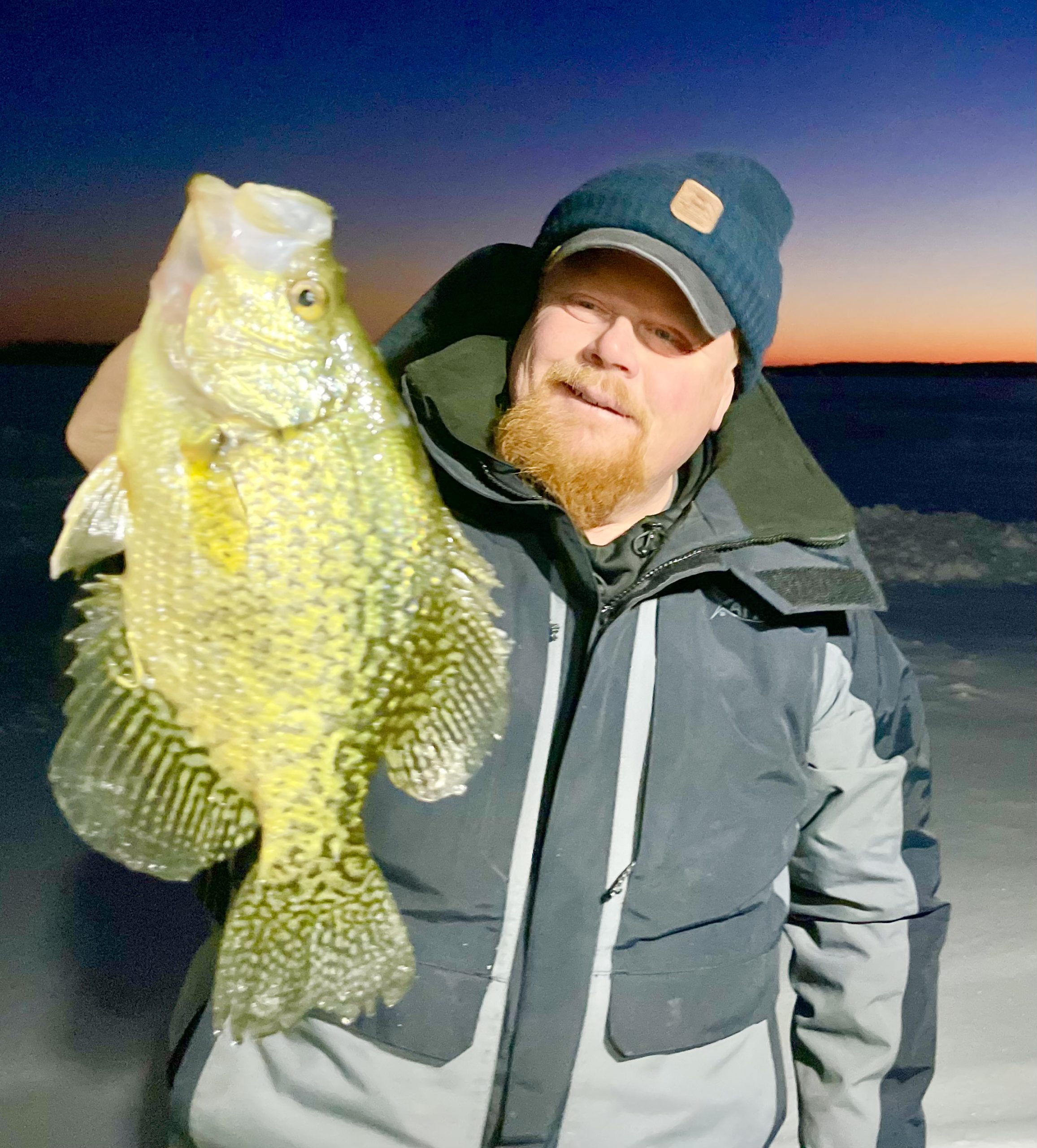
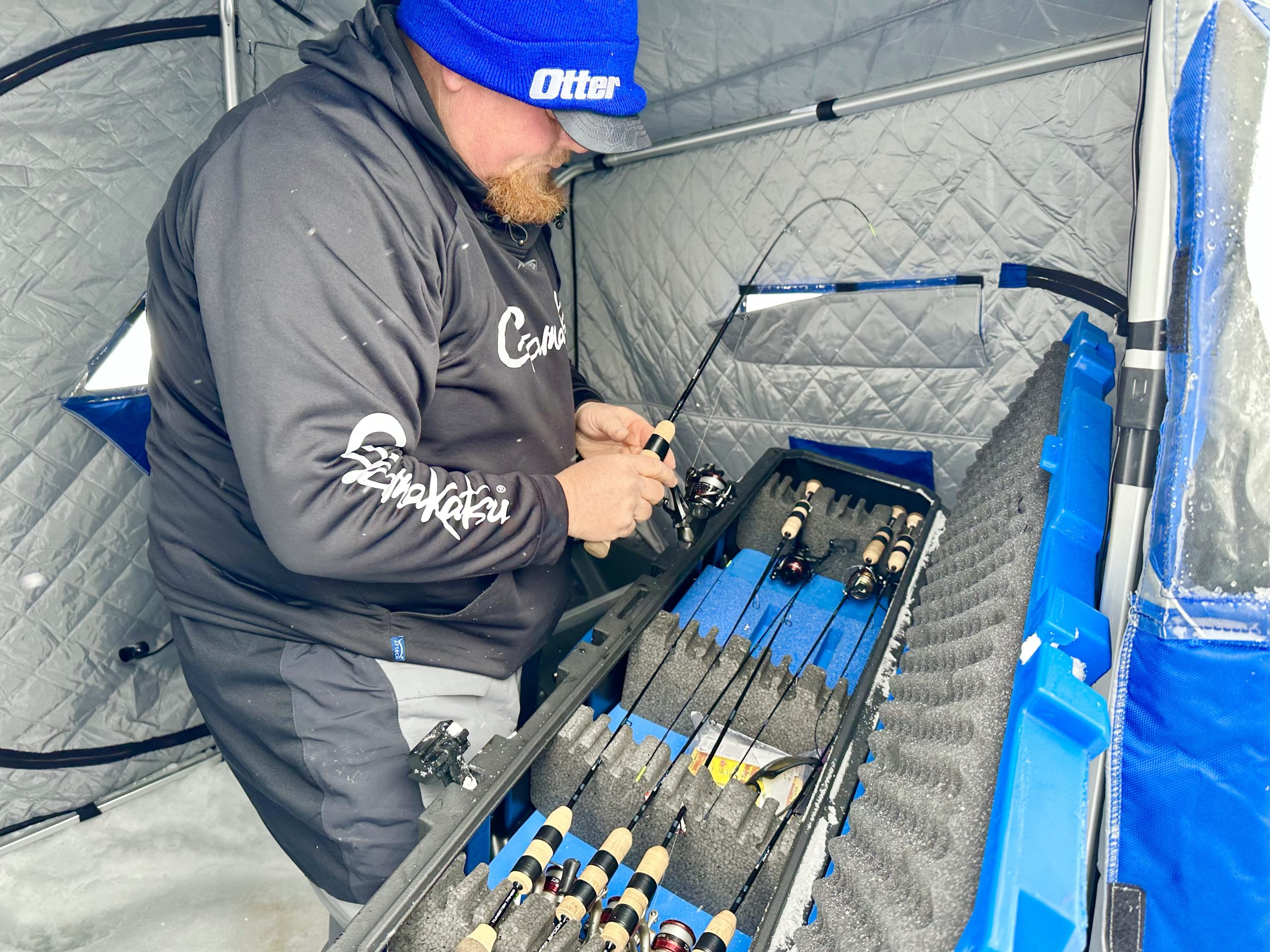
Sunset cruise
When the sun sets, crappies rise up in the water column, following the insect life that swims up, darting and floating. Crappies unhinge their jaws wide and swim forward, mouth open, cruising around while slowly gathering piles of micro insects, then swallowing to ingest. You can really gauge a lake’s crappie population on your Humminbird MEGA Live at dark when they seemingly come out of the woodwork and sometimes be hard to coax to bite.
I find that a little noise can get their attention. Small spoons with a rattle or flicker blade will draw their attention and bring them to bite. Many times, I have had crappies in this zombie state swim up and appear to fall asleep next to a set line with a minnow. I have dropped a small Northland Tungsten Buck-Shot Spoon in the hole next to it and immediately got a reaction strike from the crappie. A couple of wax worms or a small minnow head seems to be the trick. Glow colors like wonder bread or red glow can help, but on gin-clear lakes, anglers should try other colors and patterns at night. You might be surprised how they react!
The Tungsten Slim Spoon drops fast and has a small flicker blade; when the horde of zombie crappies come through, you must get down there fast and entice them with shimmy movements and light, flicker-blade clicks. Daytime crappies sometimes make anglers with forward viewing electronics chase them around on the ice, sometimes in giant circles. But at night, in the muddy holes, the zombie horde of crappies cruises in slow semi-circles through the insect-rich area. They are less spooky, so anglers can set up a blockade of fishing lines to coax bites.
Best basins
Over the past several years, the dart has been all over the target on ice thickness. Last year, we had temperatures pushing into the 80s in part of Minnesota, with 60s and 70s to the north. The old saying is, “You get what you get from Mother Nature.” Ice anglers must be their own advocates, drilling and measuring ice as you proceed using the DNR-recommended safety guidelines.
Look for deeper holes or basin areas adjacent to expansive weed flats. Basins can vary in depths from lake to lake. For example, one lake I fish has a maximum depth of 19 feet and the crappies hold in 16 feet. That being said, we are not always fishing the very bottom of the basin. We are fishing the part of the basin that has the most insect-productive mud. I have seen lakes that chart as deep as 90 feet, but the crappies hold in basins from 28 to 38 feet. On a few lakes, anglers find them in the 40s to over 50-foot depths. I avoid barotrauma (aka exploding crappies) as much as possible by staying in the low 20-foot range. Anglers fishing deep shouldn’t sort caught fish. Keep what you catch for a meal and move on to another bite such as perch or walleyes.
Larger lakes with good crappie populations have fish that hold to the basin around multiple humps and bars, especially if these structures hold vegetation during summer. When weeds die in late summer through fall, they pulverize and sink to surrounding basins, creating food for insects to eat. A lot of insect life feeds on decaying matter in the basin; they are like little janitors cleaning up the mess. Plus, this matter is the best natural fertilizer. Some lakes have a great nighttime crappie bite on basin flats in the low 20s, even though the lake may hold super deep depths even over 100 feet.
Are you enjoying this post?
You can be among the first to get the latest info on where to go, what to use and how to use it!
Timing is everything
Some of the best basin bites take a while to set up. Every winter is different, but popular lakes typically have known feeding areas or community spots. Sometimes, those spots won’t have fish, but the classic spots always seem to hold crappies. The mitigating factors are timing, cold fronts and forage.
If crappies don’t have to drop deep, they hold along an edge that has cover. But the cold fronts that created all the ice will push them down into their basin winter home. At times, crappies show up at other parts of basin holes, but that’s a temporary holding pattern as they swim the expanse to find the best possible hangouts loaded with forage.
Crappies consistently show up in the same basin hotspots year after year. Sometimes, it takes a few extra days or even weeks to get there as the midwinter settles in.
Bro pro tip
I use a St. Croix Panfish Ice Combo Ultra Light rod with 1- or 2-pound test Sunline FC Ice, a split-shot, a Gamakatsu Micro V hook, and one or two waxworms deadsticked at the level of the zombie crappies without jigging or moving. Leave it in a rod holder or iFish Pro rod tip-up, spreading extra lines within legal distances for more bites. Do not set the hook; don’t tear their paper mouths. They will hook themselves.
Sharing sonar
One of my favorite things in the modern era of ice is that one sonar can help multiple anglers—an even up to three or four! Drill holes in a straight line 2 to 3 feet apart. Place the Humminbird MEGA Live down rod in the middle hole, adjusted to down mode. Then just set the sonar on top of a table in the Otter Monster Hub. Everybody can see their lures—and the fish when they come through. It’s fun, and can get competitive as a fish is deciding which line to bite! You learn what jigging cadence will trigger a bite response.
One of the best things about hub-style houses is that there isn’t a floor, so anglers can RAZR holes anywhere. I use multiple strings of LED lights attached together across the ceiling of the hub, plugged into an Amped Outdoors 12V 32Ah battery that I have tucked into one of the many storage pockets in the hub. The lights don’t seem to spook the crappies after dark on most lakes; they get used to it.
You might see me during the day, scooting around drilling holes. But after dark, I love the comfort and camaraderie of ice fishing with family and friends, plucking zombie crappies in an insulated monster hub house. If I do walk holes after the bite settles down, I wear my AFTCO Reaper Technical Hoodie so I can move around without overheating. My Fish Monkey Wooly Gloves keep my fingers dry and warm, even though I’m touching crappies, and I don’t have to take them on and off to jig or unhook fish.
Good luck chasing zombie crappies this winter!
MWO
SHARE THIS POST
You may also like...
Did you enjoy this post?
You can be among the first to get the latest info on where to go, what to use and how to use it!
Brian 'Bro' Brosdahl
Outdoor communicator Brian “Bro” Brosdahl lives in northern Minnesota. He is a walleye guide in the Cass Lake, Leech Lake and Lake Winnibigoshish areas. He is sponsored by Northland Fishing Tackle, Frabill/Plano, Aqua-Vu, Humminbird/Minn Kota, St. Croix Rods, Ranger Boats, and Evinrude. Guide inquiries: brosguideservice.com. Follow on social media.
